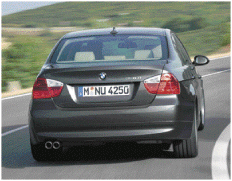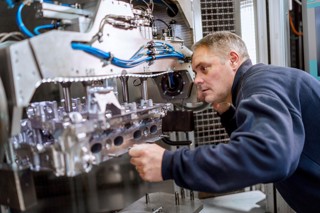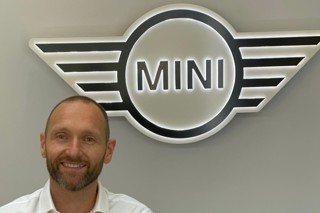The all-new model promises improved performance and fuel economy over the current 3-series saloon, and will be followed by Touring versions next summer, with coupe and convertibles likely in 2006.

Design and technology
Both front and rear overhangs are short and the cabin sits quite far back on the car compared to some similar sized front-wheel drive vehicles.
The new model is larger than before – nearly two inches longer and more than three inches wider than the existing model. It is marginally taller, but the wheelbase has grown by more than an inch.
The body shell is both stiffer and lighter and a new joint and crossbar concept for the car’s load-bearing structure ensures the new 3-series is 25% stiffer and no heavier than the current model.
Interior space has also grown, while the dashboard remains driver oriented. BMW will introduce iDrive as an option on the new 3-series and the dashboard follows the clean, minimalist style introduced with cars like the 7-series, 5-series, Z4, 6-series and 1-series.

Like other models where iDrive is available, there will be a central binnacle and control on the centre console to select options and sub-functions from communication, entertainment, navigation and other controls.
Another option called Comfort Access is a keyless entry system which also records drivers’ preferred seating and mirror positions, climate control settings and radio reception.
Customers have the choice of ‘business’ turn-by-turn navigation or ‘professional’ full map navigation, both DVD based, as well as a Harmon/Kardon Logic7 hi-fi system. BMW saloons have a long tradition of offering rear-wheel drive and 50:50 axle load distribution because of their contribution to a car’s agility, and the new 3-series will be no exception.
Active steering will be offered as an option on six-cylinder versions – a first for the upper-medium segment, which provides a more direct transmission ratio at low speeds and an indirect ratio at higher speeds.
BMW claims this solves the conflict of interest between agility, stability and comfort, where conventional steering is compromised.
The enhanced version offered in the 3-series will offer an additional feature when driving over surfaces of varying friction, such as ice patches, snow and asphalt, that intervenes to stabilise the car more quickly than most drivers would be able to.
BMW’s dynamic stability control has also been enhanced for six-cylinder models with automatic drying of the brakes on wet roads, Soft Stop (preventing the car from diving when applying the brakes slowly) and a Start-Off Assistant which prevents the car from rolling back when starting off on a gradient.

Safety
BMW is expecting five-stars for occupant protection when the new 3-series is tested by the European New Car Assessment Programme (NCAP) and has also been engineered for demanding new side crash requirements in the USA, as well as the US high-speed rear impact test.
Six airbags are standard across the range. The 3-series will have halogen headlamps as standard, but there will be optional bi-xenon headlamps, with or without an adaptive light function.
The adaptive headlights work in conjunction with the steering to provide more illumination when travelling around bends. A standard two-stage brake force display enlarges the rear brake light area when the driver makes an emergency stop or when ABS cuts in.
Drivers following the 3-series should intuitively perceive the extra illumination as emergency braking and react by pressing the brake pedal harder than they might initially have done.
Run-flat tyres will be fitted as standard across the range, allowing the driver to continue on to a repair centre for up to 155 miles at speeds of up to 50mph before replacing a punctured tyre.

Engines and transmissions
Four engines new to the 3-series will be introduced with the fifth generation model. The range-topping 330i offers a new 258bhp engine (27bhp more than the outgoing version), with 221lb-ft of torque available between 2,500rpm and 4,000rpm.
BMW has used magnesium in some engine components which offers weight savings of 30% when compared to aluminium.
The 330i will accelerate from 0-62mph in 6.3 seconds with top speed electronically limited to 155mph. However, fuel consumption on the combined cycle is 33.2mpg – a remarkable achievement for such a powerful six-cylinder engine.
The 325i has been upgraded with a 218bhp six-cylinder 2.5-litre engine replacing the 192bhp found in the current model, and offering 184lb-ft of torque from 2,750rpm to 4,250rpm.
The 320i will be fitted with a four-cylinder 2.0-litre engine, offering 150bhp and 147lb-ft, with a 0-62mph sprint time of 9.0 seconds and a top speed of 136mph plus combined fuel consumption of 38.2mpg.
The 320d receives an upgrade with the same specification engine as found in the 1-series, offering 163bhp and 251lb-ft of torque, although fuel consumption is 49.6mpg while the engine complies with Euro IV emissions rules. Top speed is 140mph and 0-62mph is cleared in 8.3 seconds.
Six-speed manual transmissions will be standard across the 3-series range, with an optional six-speed automatic. The new model will also feature a starter button to fire up the engine.


















Login to comment
Comments
No comments have been made yet.